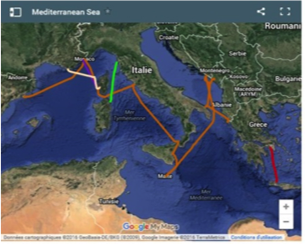

Examples of FerryBox regional coverages (from http://www.ferrybox.org/)
Aside from the 7th Ferrybox meeting which was held in Heraklion on the 7-8 April 2016, the FerryBox EuroGOOS task team met on the 6th of April 2016. This meeting was made possible with the help of the JERICO-Next project and was led by F. Colijn, HZG and W. Petersen (remotely).
One expected outcome from the JERICO-NEXT project was to “Define the specifications for a European system for handling FerryBox data, including physical, chemical and biological parameters from automated measurements as well as data from water samples”.
Underway data collected with FerryBox is a key component of multi-parameter (eg. Temperature, salinity, turbidity, Oxygen , Chlorophyll-a-concentration, pH/pCO2, Nitrates, …) coastal observations. Consequently, it is obvious that FerryBox observations have an important place in the JERICO-NEXT project.
Prior to the Heraklion meeting, the EuroGOOS task team met in Brussels (november 2014) and then remotely worked. The objective was to agree on a common approach on the FerryBox project and finally to produce a « FerryBox white book » that will clarify the roles of the different partners and that will clearly define the FerryBox infrastructure. This white book will be appliable as an EuroGOOS publication. (to be published in summer 2016).
One expected outcome from the JERICO-NEXT project was to “Define the specifications for a European system for handling FerryBox data, including physical, chemical and biological parameters from automated measurements as well as data from water samples” and it is part on the main issues adressed in the white book.
Initially, the FerryBox project was set up as an EU-FP4 project (2002-2005) and coordinated by GKSS Research Centre, Geesthacht (Germany). After the end of the project, the FerryBox observations have been mostly sustained with national contributions. HGZ has kept the leadership on the FerryBox project during the last 15 years and will continue to be the central focus point.
